Is Web3 venture capital dead?
Article Author: Joel John
Article Compiled by: Block unicorn
Over the past year, I have heard from multiple founders that fundraising has become more difficult, and I wondered why. For most of the past two years, I have been in venture capital, and I found it hard to objectively measure this sentiment, so I conducted a poll on Twitter (n = 101) to understand the situation.
While my polling method is certainly a bit rough, the consensus is clear: the seed stage fundraising environment this year is terrible. This makes sense when you consider how long it takes to complete a round of funding. Or rather, the logic is this—venture capital activity is typically closely tied to major stock indices, and we are currently in a bear market. Therefore, it should be a bad time for founders to raise funds.
I looked at about six years of data to see if this is true. This article explores how the current blockchain fundraising environment in 2023 compares to the bear market of 2018 and lays out a framework for what founders need to know about survival this year.
Big Picture
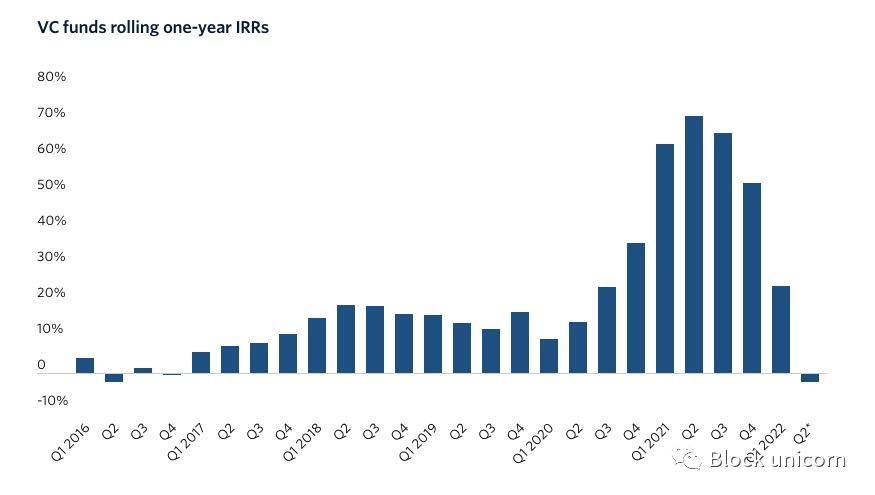
Before delving into the challenges Web3 faces through bankrupt exchanges and dysfunctional stablecoins, let’s first clarify the state of venture capital itself. We are in this strange phase where the internal rate of return for the venture market has flipped to negative for the first time in six years. This metric is an average across funds, so it can be said that, from the perspective of those putting in the money—typically institutional investors like pension funds or funds of funds—venture capital as an asset class is in a chaotic state.
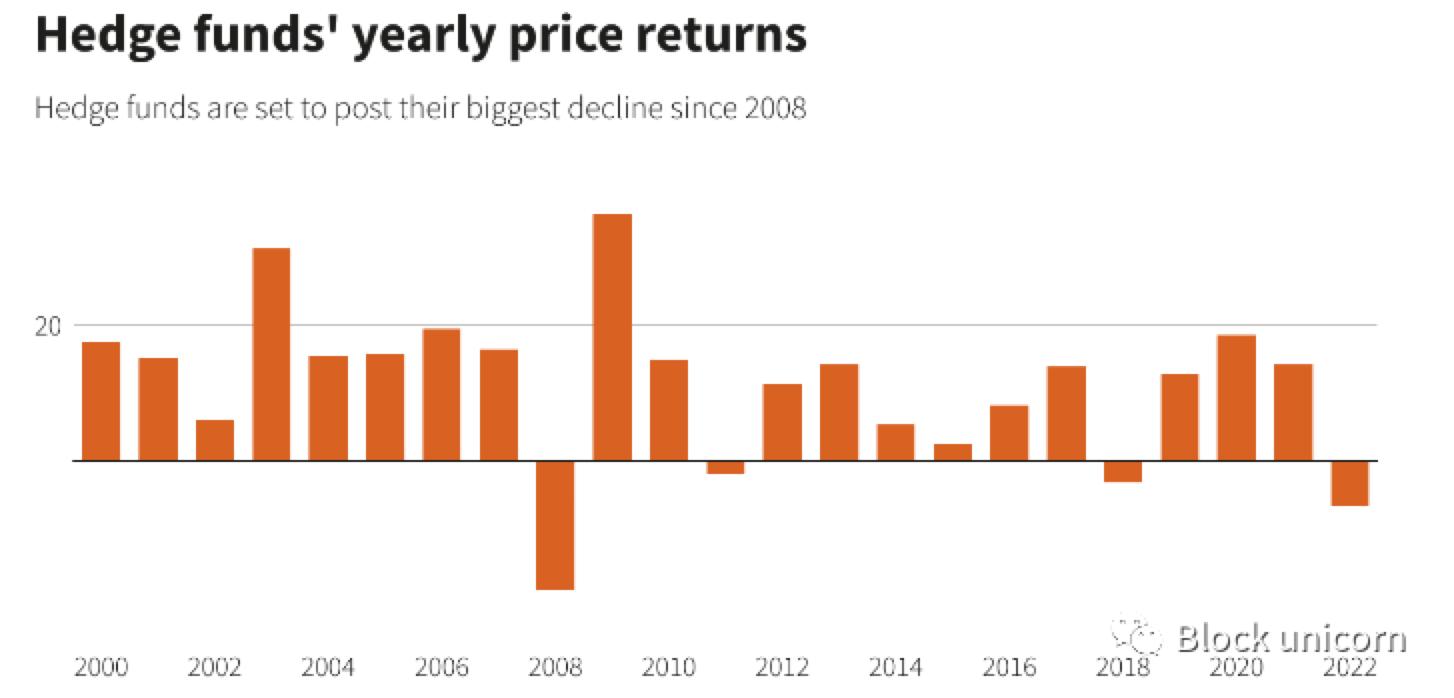
It makes no sense to observe digital assets in isolation from the venture return industry, and I am curious about the state of hedge funds, some of which actively trade these liquid instruments, and their performance also seems to be poor. It is estimated that hedge funds are about to experience their worst year since 2008, with assets under management for crypto-related hedge funds averaging a 55% decline.
Theoretically, this should lead to startups receiving less funding. Right? This was my assumption when I started writing this article, but take a look at the chart below.
In terms of total capital allocation, we just experienced a year of the second crypto bull market. Investment capital decreased by about 20% year-on-year, but it is still less than the 35% decline across the entire venture capital market.

Zooming In
Does this mean that venture capital in cryptocurrency is unscathed? Probably not. Most of the funding that appeared in 2022 occurred in January, when founders and investors returned from the cold winter to kick off the new year by announcing their funding. This is why you can see a seasonal increase in funding amounts and transaction frequency for that month. Throughout the year, we witnessed leading companies raising significant amounts of funding and salaries for the crypto track, while Do Kwon, Three Arrows Capital's Su Zhu, FTX's CEO & SBF caused tremendous harm to the industry.
Once you study the number of transactions that occurred that year, this trend becomes even more apparent. I have zoomed in on last year to show what might happen.
Notice the "crash" around February? That was the partners and analysts of venture capital funds catching their breath after the January surge, which you can also see in the 2021 numbers.
But here is the key to the data: we have returned to the venture capital frequency last seen around January 2020.
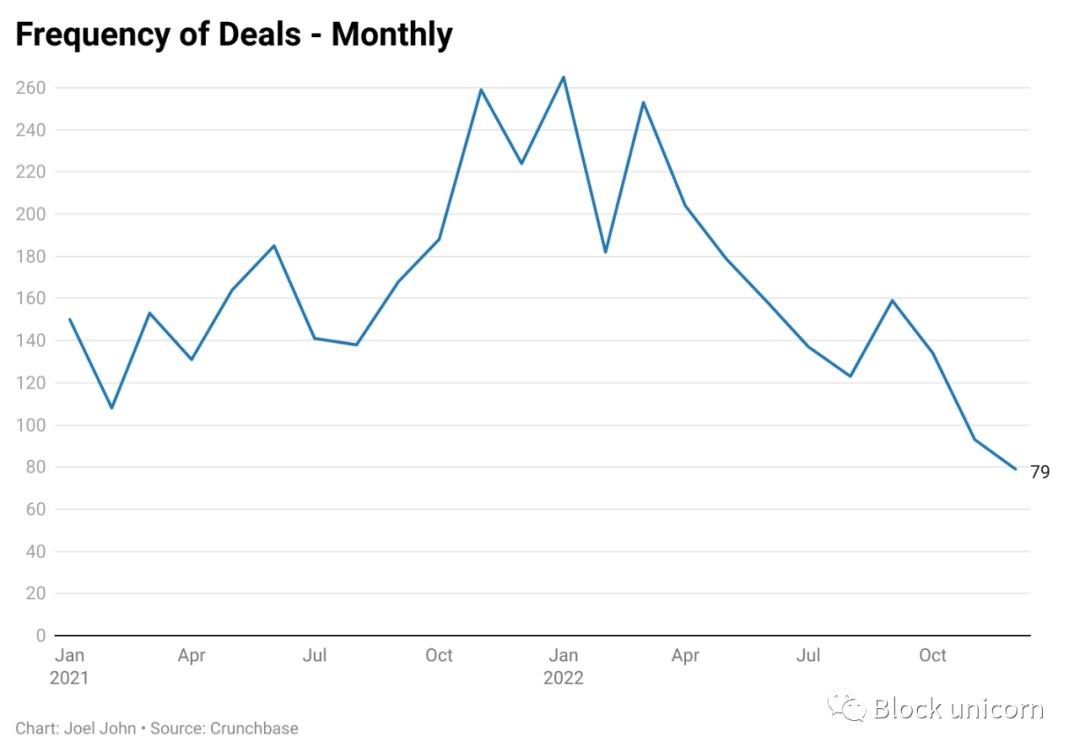
This phenomenon of reverting to the mean is also visible in capital terms. Considering the macroeconomic pullback in Q1/Q2 (rising energy prices, potential inflation), we saw the prices of digital assets drop sharply. Typically, when liquidity markets perform well, investment appetite tends to reach new highs; this indicates that Web3 investors can see exits in the form of liquid tokens.
As the market deteriorated, companies began to postpone token launches more frequently. Because no one wants to issue tokens in a crashing bear market, this means that existing positions held by investors take longer to yield returns.
In this scenario, the rational response is to hold onto unspent dollars rather than make multiple rounds of investments. This becomes very clear when we look at the amount of capital deployed.
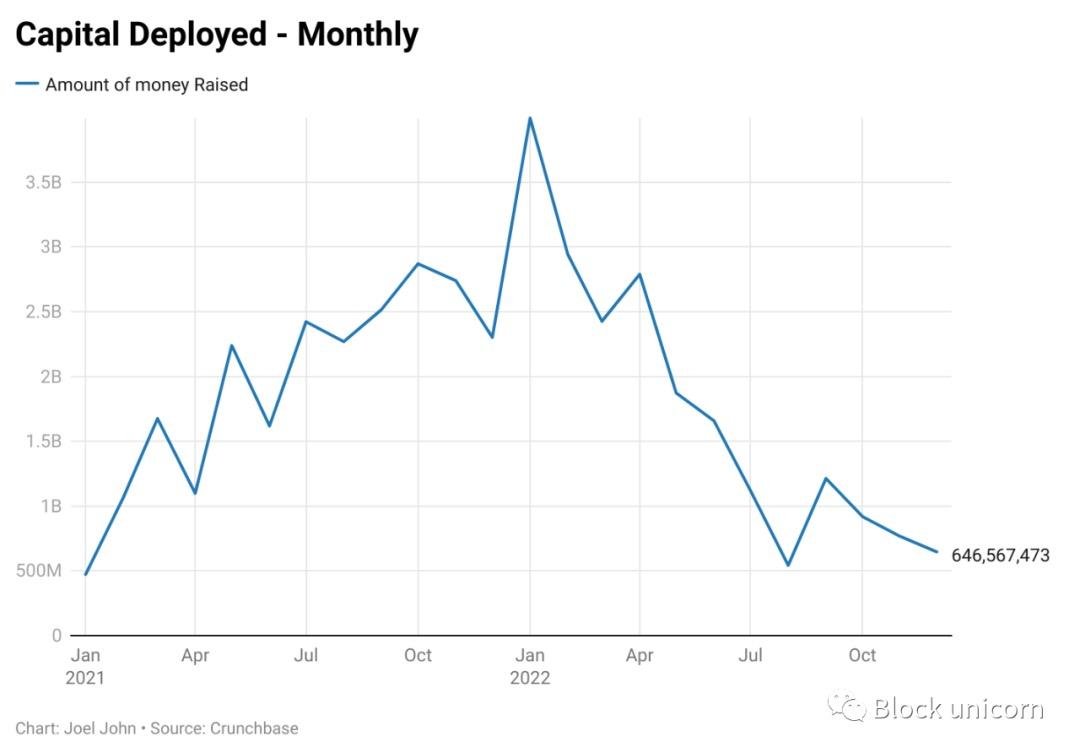
The above chart summarizes the wave of venture capital that entered the ecosystem at the end of 2021, with the tide slowly receding throughout the year. I find it fascinating that even at the current "low level" of $650 million in monthly funding, the amount of funding the blockchain ecosystem attracts today is equivalent to the total funding for the entire year of 2016.
Moreover, the number of companies in the crypto space has grown exponentially, and it would be a mistake to think we are in a massive funding freeze without considering how funding activity in this space has evolved over the past few years.
To do this, I analyzed data going back to 2017. If our downturn is as severe as the winter crash of 2018, we should see a synchronous decline in frequency similar to what was observed then.
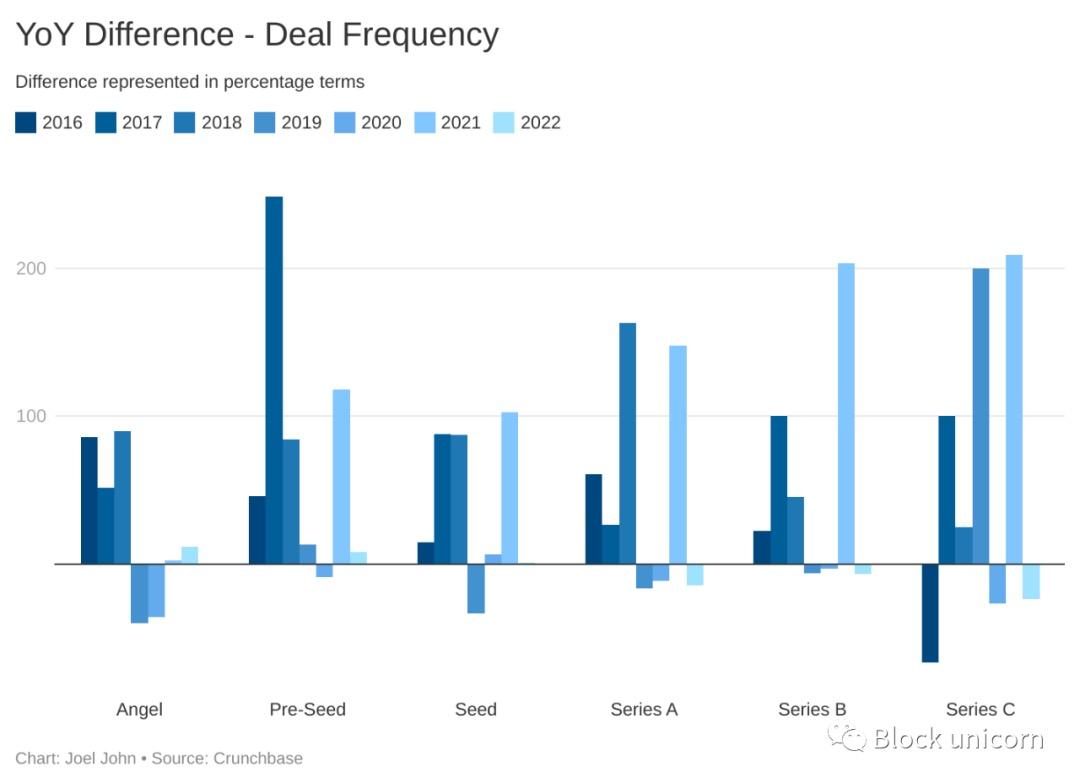
When we consider the transaction frequency over these years, we see two distinct trends. First, pre-seed and seed stages remain more resilient than in 2019. In 2019, the frequency of seed stage funding decreased by ~33%. Year on year, we envision the space maintaining positive values in 2022. Founders have been raising more funds at the seed stage to build through the bear market. Since 2020, the median amount raised at the seed stage has more than quadrupled. Now the average amount raised per round is $4.5 million.
If you look at the A, B, and C series on the right side of the chart, you will see a completely different trend, with the A series at -17% in 2019. We are at -15% in 2022, and the B and C series also began to mimic their 2019 counterparts. Founders can complete a round of funding at the early stage through friends, family, and angels, with seed stage funding now taking over two quarters in the current environment, compared to just a few days during the bull market.
For companies in the growth stage, it is nearly impossible to secure funding unless they are very attractive, but it can still happen. This becomes very clear when you study the same numbers from the perspective of capital deployment per year.
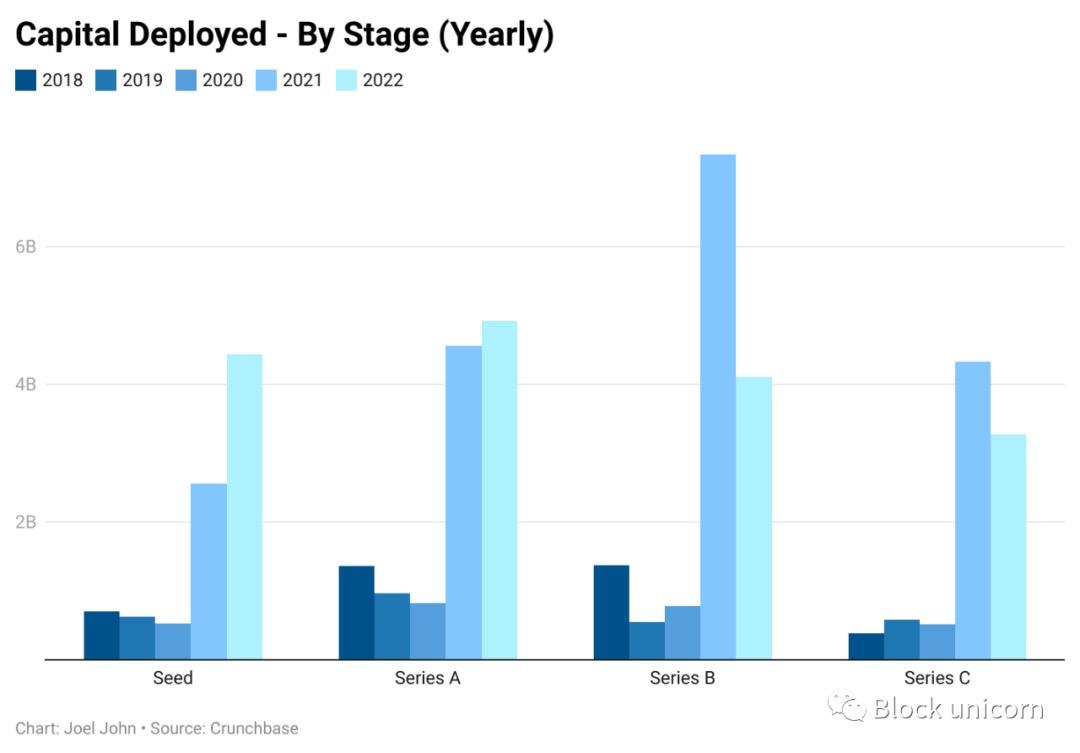
Funding entering the seed stage has doubled. While Series A has maintained the same pace, we have only seen severe contraction in the growth stage. This may be because companies are trying to stay lean early on, and having enough capital left in their pockets may mean they have enough time to weather the next bull market.
In later stages, companies have typically raised significant amounts of capital and hired many employees. In a high burn rate scenario, the likelihood of surviving 36 to 48 months to weather market sentiment changes is relatively low.
If you are a growth stage investor and find that the valuations of the stocks you have bet on have dropped significantly, you typically have two options. The first is to enter earlier stages (seed, Series A) and join earlier rounds. This explains why we see companies that previously only participated in later stages now also joining early funding rounds. From a portfolio construction perspective, it lowers the valuations you deploy and increases your stake in different companies.
The second option is to double down on companies that are already doing well, which is why attractive companies often receive astonishing investments.
What You Need to Know
What does all this mean for entrepreneurs in today’s market? It is worth remembering that, contrary to public opinion, there is more capital and transactions happening in the crypto space now than in 2020. The chart below lists the transaction frequency over the past two years, broken down by stage.
If you are at the seed or pre-seed stage, then your fears are unfounded. The same number of transactions are occurring, and the capital entering the ecosystem is double what it was originally.
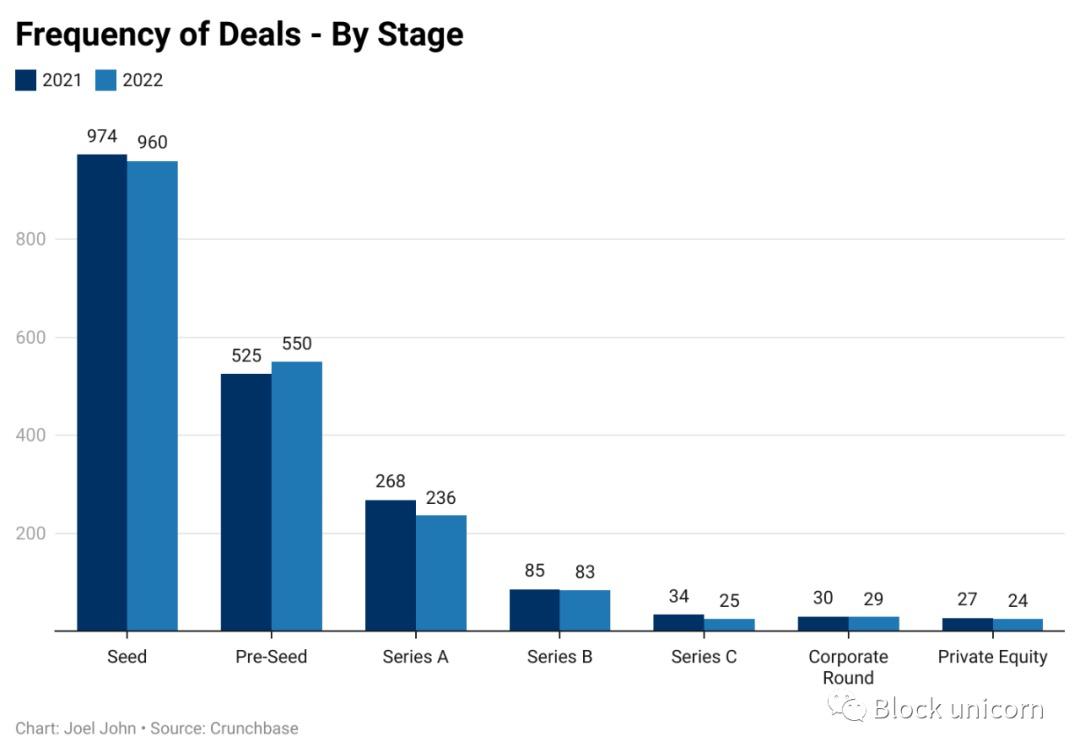
This serves the interests of those deploying capital, making those raising funds (you or other founders) believe that the sky is falling. This allows them to push for more favorable valuations while giving them ample time to consider other risks they can deploy. There is no coordinated conspiracy to make founders believe that venture capital is about to freeze. Instead, it is the invisible hand of the market, as Adam Smith would say: a series of forces conspire to make you believe that there are no buyers left in the market.
This is how it works: in a bear market, venture capitalists with funds to deploy can choose to wait for the "perfect" opportunity to arise. As the saying goes, the pendulum of the market swings in their direction, and each company needs more time to conduct due diligence and return to its founders.
What takes just a few days in a bull market often takes months in a bear market. Partners at large VC firms will start conversations with founders based on attractiveness metrics rather than asking who else is joining the round. Founders interpret this indifference from venture capitalists as a lack of funds in the market. It is not a lack of money that leads to this behavior, but a lack of conviction.
But there is another reason for this madness: we think that it is the worst thing in the world for startups to be unable to raise follow-on funding. We believe that in a market where the cost of failure has dropped to zero in 2023, failure is an unacceptable outcome.
Until the 1990s, entrepreneurship was rarely seen as a viable career path for young professionals. You either took on debt or were born into a wealthy family, and venture capital reversed this trend during the internet boom.
Harvard visiting scholar Ramana Nanda provides the best explanation for what is happening now. His report titled "The Cost of Experimentation and the Evolution of Venture Capital" explores how the declining costs of entrepreneurship have affected the quality of founders and the investment styles of their backers:
"The declining costs of starting new ventures have enabled some entrepreneurs who previously could not access financing to obtain early-stage funding. While the expected value of these newly viable marginal ventures is lower, they seem to be primarily composed of ventures with lower probabilities of success but higher returns if successful (what we call 'high-risk ventures'), rather than 'poor' ventures that have lower total returns if successful. We find that in industries affected by technological shocks, venture capital has increased investment in startups operated by younger, less experienced founding teams.
While these characteristics align with the lore of 'high-risk bets' founded by young, inexperienced founders like Google, Facebook, Airbnb, and Dropbox, they also align with broader alternative mechanisms that suggest that marginal ventures are simply worse investments."
Ramana Nanda wrote this article in 2015, nearly a decade after the launch of Amazon Web Services (AWS). Why is this important? Because AWS and Google Ads changed the unit economics of entrepreneurship. They made it possible for anyone to launch a server and sell to someone on the other side of the globe.
For example, Y Combinator relies on an increasing number of young people who often do not know better than to go out and create the raw tools we use on the internet every day today. Of course, the failure rates of these businesses have historically been— and still are—quite high. But overall, startups in the world that have received venture capital are better off than those that have not.
Cold Winter and Reserve Capital
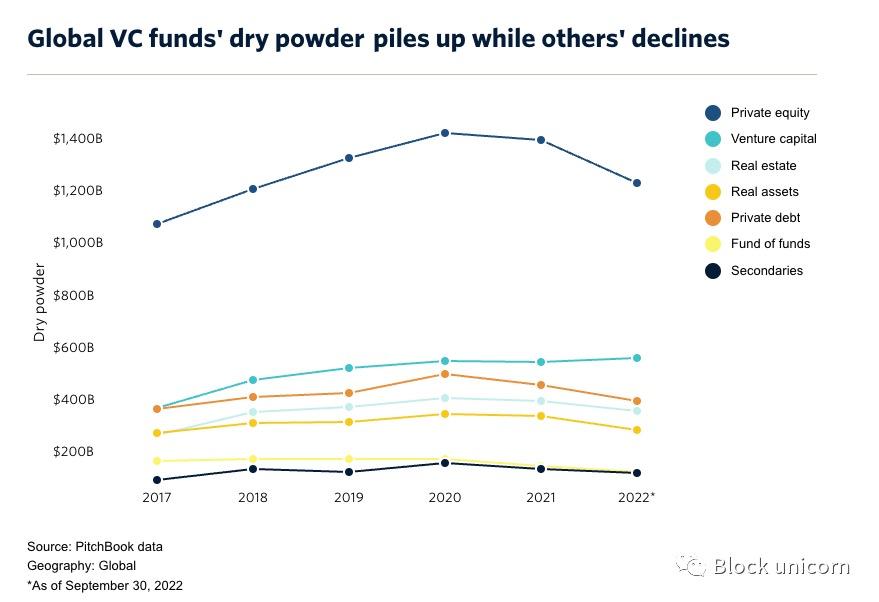
Venture capital is one of the few private tools whose market entry volume has increased compared to 2022. According to various sources, there is $300 billion to $600 billion of cumulative capital yet to be deployed. A significant portion of this capital is merely "promised," and if we experience a comprehensive recession like in 2008, venture capital firms may retract the funds they have raised, as seen during the 2008 financial crisis and the internet bubble.
Many founders operate under the assumption that venture capital firms will have to continue deploying funds at some point. And this is indeed the case, but if the data tells us anything, it is these two things:
1. Early-stage venture capital is occurring at a high frequency, with increasing amounts of capital. A significant portion of these startups may fail, and rapid failure is an ideal outcome as it saves time and energy for all participants. Venture capital firms typically set valuations to optimize ownership when these startups take off.
2. Growth-stage companies that can demonstrate meaningful attractiveness will have excess capital piling up there. Compared to their peers, these companies will raise funds at higher prices, creating a seller's market. Founders get the valuations they ask for because there is too much money chasing too few deals.
The chaos in the middle is what most founders want to avoid. In this space, you have raised enough capital to grab headlines and attract the best talent, but you lack a clear direction to achieve product-market fit. The worst thing for a company is not to go bankrupt. It is the indifference from customers, teams, and investors. Slowly bleeding out, battered and bruised, serves as a reminder that no one cares about what you are fully invested in.
What I refer to as this "chaos in the middle" typically occurs around Series A, as at this stage, you have "validated" your risk through venture capital or media companies from the outside rather than through paying customers. This is why, at these stages, the conversation around fundraising first needs to establish the key metrics of the business. If that number does not exist, subsequent funding will not come quickly.
I do not want to create fear here. But it is worth acknowledging that there will be failures along the way. DAOs are no longer allocating funds as they once did, ecosystem grants are the lifeblood of the industry, but they have reduced the deployment of capital. As tech companies lay off employees, angel investors who gained wealth from IPOs and high-valued token listings are now competing for jobs.
Will the next few months only bring good days? Probably not. Especially if the macroeconomic environment remains unchanged. But things are not as bad as we imagine in the private market; seed stage activity is still high. Later-stage deals are also raising the same amount of capital. If you are building and have data to validate your assumptions, then there is not much to worry about.










